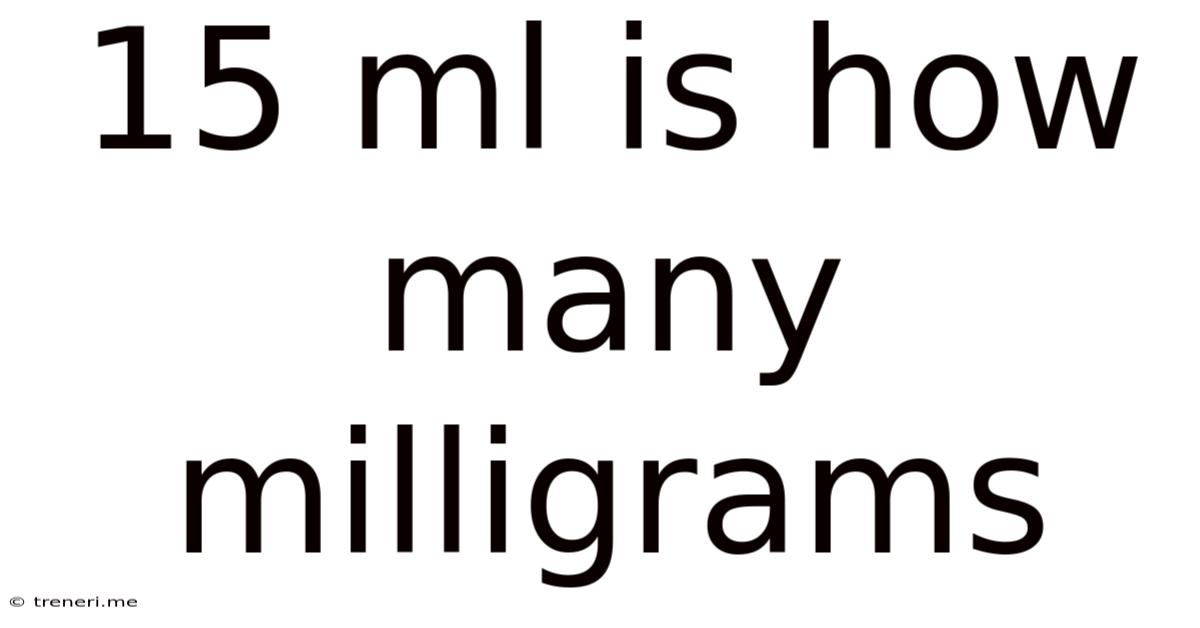15 Ml Is How Many Milligrams
Treneri
May 14, 2025 · 4 min read

Table of Contents
15 ml is How Many Milligrams? Understanding Volume vs. Mass
The question "15 ml is how many milligrams?" highlights a crucial distinction in measurement: volume versus mass. Milliliters (ml) measure volume, which is the amount of space a substance occupies. Milligrams (mg) measure mass, which is the amount of matter in a substance. You cannot directly convert between the two without knowing the density of the substance. Density is the mass per unit volume (usually expressed as g/ml or kg/L).
This article will delve into understanding this critical difference, explaining the concepts of volume and mass, density's role in the conversion, and providing examples to clarify the process. We'll also address common misconceptions and explore relevant scenarios where this conversion is crucial.
Understanding Volume and Mass
Before we attempt any conversion, it's vital to grasp the fundamental difference between volume and mass:
-
Volume: This refers to the three-dimensional space occupied by a substance. Think of it as how much "room" something takes up. Common units of volume include liters (L), milliliters (ml), cubic centimeters (cm³), and gallons (gal). 1 ml is equivalent to 1 cm³.
-
Mass: This refers to the amount of matter in a substance. It's essentially how much "stuff" is present. Common units of mass include kilograms (kg), grams (g), and milligrams (mg).
The relationship between volume and mass is governed by density.
The Crucial Role of Density
Density is the key to converting between volume and mass. It's defined as the mass of a substance per unit volume. The formula is:
Density (ρ) = Mass (m) / Volume (V)
Therefore, to find the mass (in milligrams) of 15 ml of a substance, we need to know its density. Different substances have different densities. For example:
- Water: At 4°C, the density of water is approximately 1 g/ml (or 1000 mg/ml).
- Mercury: Mercury is much denser than water, with a density of approximately 13.6 g/ml.
- Air: Air has a significantly lower density, around 1.2 g/L (or 0.0012 g/ml).
Calculating Mass from Volume and Density
Let's illustrate the calculation with examples:
Example 1: Water
If we have 15 ml of water, and we know the density of water is approximately 1 g/ml, we can calculate the mass:
-
Convert ml to g: 15 ml * 1 g/ml = 15 g
-
Convert g to mg: 15 g * 1000 mg/g = 15000 mg
Therefore, 15 ml of water has a mass of approximately 15000 mg.
Example 2: Mercury
Now let's consider 15 ml of mercury, with a density of approximately 13.6 g/ml:
-
Convert ml to g: 15 ml * 13.6 g/ml = 204 g
-
Convert g to mg: 204 g * 1000 mg/g = 204000 mg
Therefore, 15 ml of mercury has a mass of approximately 204000 mg.
Example 3: A Substance with Unknown Density
If you have 15 ml of an unknown substance, you cannot determine the mass in milligrams without knowing its density. You would need to either look up the density in a reference book or measure it experimentally using a balance and a graduated cylinder.
Common Misconceptions
A frequent mistake is to assume that 1 ml always equals a specific mass in milligrams. This is incorrect; the conversion depends entirely on the substance's density. Always remember that volume and mass are distinct properties.
Practical Applications
The conversion between volume and mass is essential in various fields:
- Medicine: Calculating drug dosages often involves converting between volume (e.g., ml of a solution) and mass (e.g., mg of active ingredient).
- Chemistry: In chemical reactions, the mass of reactants and products is crucial. Knowing the volume and density of solutions allows for accurate calculations.
- Physics: Density is a fundamental physical property used in many calculations, including buoyancy and fluid dynamics.
- Engineering: Density considerations are important in designing structures and ensuring stability.
Advanced Considerations: Temperature and Pressure
The density of a substance can be affected by temperature and pressure. For highly accurate conversions, these factors must be considered. For example, the density of water changes slightly with temperature; it's highest at 4°C.
Conclusion
Determining how many milligrams are in 15 ml requires understanding the concept of density. There's no single answer; the mass depends entirely on the substance's density. This article has explored the fundamental differences between volume and mass, the role of density in the conversion, and practical applications where this conversion is critical. Remember to always consider the density of the substance before attempting to convert between volume and mass. Accurate calculations rely on precise knowledge of this crucial physical property. Failing to account for density will lead to inaccurate and potentially problematic results in various scientific, engineering, and medical applications. Always refer to reliable sources for density values and consider factors like temperature and pressure for highly accurate calculations.
Latest Posts
Latest Posts
-
How Many Quarts Are In 6 Cups
May 14, 2025
-
What Fractions Are Equivalent To 2 5
May 14, 2025
-
90 Days From October 5 2023
May 14, 2025
-
Cuanto Falta Para El 27 De Diciembre
May 14, 2025
-
Cuanto Es 2 Grados Fahrenheit En Centigrados
May 14, 2025
Related Post
Thank you for visiting our website which covers about 15 Ml Is How Many Milligrams . We hope the information provided has been useful to you. Feel free to contact us if you have any questions or need further assistance. See you next time and don't miss to bookmark.